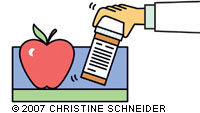
High-tech, high-cost procedures may get all the glory in health care, but they signal our failure to reward prevention.
Fam Pract Manag. 2007;14(8):52
Dr. Frank is an assistant professor in the University of Wisconsin Department of Family Medicine and medical director of Fox Valley Family Medicine in Appleton, Wis. Author disclosure: nothing to disclose.

Years ago, when I was a third-year resident at a community hospital, I was called to the emergency department late one night to evaluate a 56-year-old woman who was dehydrated. Mary (not her real name) had been diagnosed with type-2 diabetes mellitus 15 years earlier but had been off her meds and received essentially no medical care for the preceding two years. Recently, she had reported a history of polydipsia and polyuria. She had been drinking large amounts of sweet tea, lemonade and soda, and she expressed surprise that these would be poor beverage choices for someone with diabetes. Her initial evaluation revealed a probable urinary tract infection along with hyperglycemia and hypovolemia. She was started on antibiotics, intravenous fluids and insulin.
Overnight, Mary became septic, and she was in septic shock by early the next morning. Her situation declined steadily, and she became too unstable to transport to critical care at another facility. My attending physician communicated by phone with the ICU at our referral hospital until the critical care attending and fellow could arrive and bring their critical care experience to our patient.
Watching the two intensivists work was amazing. Mary coded numerous times, and each time they worked quickly to resuscitate her. After several hours, Mary was stable enough for transport. She left with a high likelihood of not surviving the next 48 hours.
Forty-five days later, Mary walked into our hospital to say thank you. She had been in the ICU for six weeks but was now completely recovered and committed to managing her diabetes. I was once again amazed at the life-saving ability of the critical care team.
However, as I reflected further on the situation, I realized that although the manner in which Mary had been resuscitated and ultimately healed was exciting and a testament to the innovations of critical care medicine, it was no more noble than our feats in primary care.
As a family physician, I have the opportunity to save the lives of my patients every day. For example, helping patients with diabetes to lower their A1Cs, take their medication, stop smoking, start exercising, control their blood pressure or a host of other primary, secondary and tertiary prevention measures keeps patients from ever getting to the ICU in Mary's condition. Yet this type of “life saving” is not appreciated and glorified in the same way as critical care. It is much more exciting to see a critically ill patient saved from the brink of death than to see a primary care physician initiate aspirin chemoprophylaxis. The U.S. medical community is just as enamored with highly specialized, resource-intensive medicine as is the audience of “ER.”
While it is a strength of our health care system that we can perform interventions that save critically ill patients, it is a failure of our system that the majority of our training and spending is focused on high-tech interventions for a few patients rather than preventive care that would aid thousands more. For example, screening for and preventing the complications of hyperlipidemia is often not reimbursable, but the cardiac catheterization five years later to evaluate and treat coronary artery disease is highly reimbursable. It seems our system is set up to reward failure – the failure to prevent disease.
As a family physician, I love the challenge of helping a patient recognize the need to initiate lifestyle change, the teamwork of deciding with the patient what she can reasonably do within the context of her life situation, and the thrill of sharing her success as she loses weight, gets her diabetes under control or is able to avoid a hospitalization. Too often, however, I encounter patients who simply want whatever magic pill or procedure will treat their disease. It is difficult to understand why they would resist simple, proven strategies such as diet and exercise, which could be so beneficial in their disease management. But then I look around at what is advertised and glorified on television and how our country spends the majority of our health care dollars. It is no wonder that my patients see a pill or a surgery as the best solution.